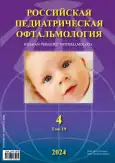Anterior diffuse scleritis, map-like corneal ulcer, and hypopyon anterior uveitis associated with herpes zoster
- Authors: Kovaleva L.A.1,2, Balatskaya N.V.1, Krichevskaya G.I.1, Baisangurova A.A.1
-
Affiliations:
- Helmholtz National Medical Research Center of Eye Diseases
- Russian University of Medicine
- Issue: Vol 19, No 4 (2024)
- Pages: 239-247
- Section: Case reports
- Published: 15.12.2024
- URL: https://ruspoj.com/1993-1859/article/view/641571
- DOI: https://doi.org/10.17816/rpoj641571
- ID: 641571
Cite item
Abstract
AIM: To analyze etiopathogenesis, clinical features, and a treatment algorithm for acute anterior diffuse scleritis, map-like corneal ulcer, and hypopyon anterior uveitis in order to increase medical awareness of herpes zoster in children.
RESULTS: Long-term exposure to rapid temperature changes contributed to varicella-zoster virus (VZV) reactivation in a child leading to herpes zoster rarely occurring in children, onset of anterior diffuse scleritis and hypopyon anterior uveitis. Corticosteroid therapy without causal treatment led to herpes virus reactivation in the patient’s cornea which contributed to herpes corneal ulcer.
CONCLUSION: Etiopathogenesis features were analyzed, characteristic clinical symptoms of anterior diffuse scleritis, herpes corneal ulcer, and hypopyon anterior uveitis caused by varicella-zoster virus (VZV) reactivation were described. Reactivation led to herpes zoster with skin eruption and herpes zoster ophthalmicus, such as injury of the ophthalmic branch of the trigeminal nerve without extraocular (skin) symptoms of herpes infection. The VZV etiological role was established based on high titers of anti-VZV IgG antibodies, the presence of anti-VZV-gE IgG antibodies (markers of active viral replication), and the efficacy of anti-herpes therapy. The described clinical symptoms of combined ophthalmic pathology contribute to the early diagnosis of ocular herpes for timely antiviral herpes therapy to prevent chronic disease and complications and to preserve and/or recover visual acuity.
Full Text
About the authors
Lyudmila A. Kovaleva
Helmholtz National Medical Research Center of Eye Diseases; Russian University of Medicine
Author for correspondence.
Email: ulcer.64@mail.ru
ORCID iD: 0000-0001-6239-9553
SPIN-code: 1406-5609
MD, Cand. Sci. (Medicine)
Russian Federation, Moscow; MoscowNatalya V. Balatskaya
Helmholtz National Medical Research Center of Eye Diseases
Email: balnat07@rambler.ru
ORCID iD: 0000-0001-8007-6643
SPIN-code: 4912-5709
Cand. Sci. (Biology)
Russian Federation, MoscowGalina I. Krichevskaya
Helmholtz National Medical Research Center of Eye Diseases
Email: gkri@yandex.ru
ORCID iD: 0000-0001-7052-3294
SPIN-code: 6808-0922
MD, Cand. Sci. (Medicine)
Russian Federation, MoscowAlbina A. Baisangurova
Helmholtz National Medical Research Center of Eye Diseases
Email: alia-bai-5@mail.ru
ORCID iD: 0000-0002-8014-667X
SPIN-code: 2308-0920
MD, Ophthalmologist
Russian Federation, MoscowReferences
- Vikulov GKh, Oradovskaya IV, Kolobukhina LV. Herpesvirus infections in children: prevalence, incidence, clinical forms, and management algorithm. Clinical practice in pediatrics. 2022;17(6):126–141. EDN: QQTSMW doi: 10.20953/1817-7646-2022-6-126-140
- Roizman BK, Knipe D, Whitley RJ. Herpes simplex viruses. Philadelphia: Lippincott-Williams &Wilkins; 2013. Р. 1823–1897.
- Poole E, Wills M, Sinclair J. Human cytomegalovirus latency: targeting differences in the latently infected cell with a view to clearing latent infection. New J Sci. 2014;2:1–10. doi: 10.1155/2014/313761
- Arvin A, Campadelli-Fiume G, Mocarski E, et al. Human herpesviruses: biology, therapy, and immunoprophylaxis. Cambridge: Cambridge University Press; 2007. doi: 10.1017/CBO9780511545313
- West JA, Gregory SM, Damania B. Toll-like receptor sensing of human herpesvirus infection. Front Cell Infect Microbiol. 2012;2:122. doi: 10.3389/fcimb.2012.00122
- Alekseev KP, Alimbarova LM, Aliper TI, et al. Viruses and viral infections of humans and animals. Handbook of virology. Moscow: Meditsinskoe informatsionnoe agentstvo; 2013. 1200 р. EDN: TLZMHF
- Vikulov GKh. Human herpesvirus infections in the new millennium: classification, epidemiology, and sociomedical importance. Epidemiology and infectious diseases. Current items. 2014;(3):35–40. EDN: SWNYJN
- Zhang J, Liu H, Wei B. Immune response of T cells during herpes simplex virus type 1 (HSV-1) infection. J Zhejiang Univ Sci B. 2017;18(4):277–288. doi: 10.1631/jzus.B1600460
- Zheng W, Xu Q, Zhang Y, et al. Toll-like receptor-mediated innate immunity against herpesviridae infection: a current perspective on viral infection signaling pathways. Virol J. 2020;17(1):192. doi: 10.1186/s12985-020-01463-2
- Connolly SA, Jardetzky TS, Longnecker R. The structural basis of herpesvirus entry. Nat Rev Microbiol. 2021;19(2):110–121. doi: 10.1038/s41579-020-00448-w
- Maksimova MY. Neurological disorders in herpes zoster. MedicaMente. Lechim s umom. 2017;3(1):21–24. (In Russ.) EDN: ZIVSVL
- Kennedy PG, Gershon AA. Clinical features of varicella-zoster virus infection. Viruses. 2018;10(11):609. doi: 10.3390/v10110609
- Gershon AA, Breuer J, Cohen JI, et al. Varicella zoster virus infection. Nat Rev Dis Primers. 2015;1:15016. doi: 10.1038/nrdp.2015.16
- Mitra B, Chopra A, Talukdar K, et al. Clinico-epidemiological study of childhood herpes zoster. Indian Dermatol Online J. 2018;9(6):383–388. doi: 10.4103/idoj.IDOJ_107_18
- Hakim FE, Riaz K, Farooq A. Pediatric herpes zoster ophthalmicus: a systematic review. Graefes Arch Clin Exp Ophthalmol. 2023;261(8):2169–2179. doi: 10.1007/s00417-023-06033-0
- Anne L, Mounsey MD, Leah G, et al. Herpes zoster and postherpetic neuralgia: treatment and prevention. Russian Journal of Skin and Venereal Diseases. 2007;(S2):54–57. (In Russ.) EDN: IBIDTF
- Khaldin AA. Postherpetic neuralgia: possible therapeutic consensus of dermatologists and neurologists. Klinicheskaya dermatologiya i venerologiya = Russian journal of clinical dermatology and venereology. 2018;17(1):77–81. EDN: YURDON doi: 10.17116/klinderma201817177-81
- Molochkov VA, Shabalin VN, Kryazheva SS, Romanenko GF. Manual on gerontological dermatology. Moscow: MONIKI; 2004. 359 р. (In Russ.) EDN: QLLPGZ
- Kong CL, Thompson RR, Porco TC, et al. Incidence rate of herpes zoster ophthalmicus: a retrospective cohort study from 1994 through 2018. Ophthalmology. 2020;127(3):324–330. doi: 10.1016/j.ophtha.2019.10.001
- Vikulov GKh, Maksimova MYu, Voznesenskiy SL, et al. Herpes zoster: epidemiology, clinical manifestations, algorithms of diagnosis, treatment, and prevention. Infectious Disease. 2019;17(2):105–120. EDN: KDCPXT doi: 10.20953/1729-9225-2019-2-105-120
- Lavrov VF, Svitich OA, Kazanova AS, et al. Varicella Zoster virus infection: immunity, diagnosis and modelling in vivo. Journal of microbiology, epidemiology and immunobiology = Zhurnal mikrobiologii, epidemiologii i immunobiologii. 2019;(4):82–89. EDN: HWKYDO doi: 10.36233/0372-9311-2019-4-82-89
- Kovaleva LA, Krichevskaya GI, Davydova GA, Zaitseva AA. Chronic unilateral anterior nodular scleritis with local inflammation of the ciliary body associated with the varicella-zoster virus. Russian pediatric ophthalmology = Rossiyskaya pediatricheskaya oftal’mologiya. 2022;17(2):31–38. EDN: HZNBGM doi: 10.17816/rpoj105641
- State report of the Federal Service for Supervision of Consumer Rights Protection and Human Welfare “On the state of sanitary-epidemiological well-being of the population in the Russian Federation in 2021”. (In Russ.) Available from: https://base.garant.ru/409074716/. Accessed: 05.11.2024.
Supplementary files









